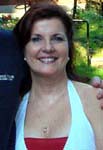Prefitting the Jacket
With a new jacket pattern, especially, this is the place where I stop and test the fit.
Since I had worked out the major fitting issues with a “muslin” of Pellon Tru-Grid, as described in Step 2 of this web log, this step should involve tweaking the pattern a bit, as opposed to making major changes. Tweaking the fit is usually required because a jacket’s fit in the fashion fabric can often be slightly different from that in the muslin, especially if the fashion fabric has been underlined, which adds to the “meat” of the fabric.
As excited as I am to rush full steam ahead, at this point, into the jacket assembly, I rein myself in one more time to adjust the bit, so to speak. I don’t like to do a full press on a seam only to have to rip it out to tweak the fit at a later stage. So I patiently assemble the jacket for this fitting stage by machine basting as many seams as are necessary, steaming them lightly to get them to lie flat only well enough so that the fit can be determined. I only do a final press on a seam when it has been “approved”.
I am small in the shoulders with an average size bust, so my fitting issues are often centered on the fit of upper bodice and shoulders. For this reason, I sometimes baste in the sleeves as well. The fit of the sleeve onto the armhole can sometimes change the look of the upper bodice pretty dramatically, I have found. I really dislike a fitted jacket with folds in front of the armholes or creases radiating from the armhole to the bust. These problems have usually been worked out in the muslin stage, but can still be an issue for me in the fashion fabric.
In addition, if the fabric wants to form a convex indentation between the shoulder and the bust, I know I should add a chest shield to the underside of the jacket. A chest shield is an additional piece of interfacing from the shoulder to just below the armhole notch, and is designed to help that area lie smooth. I don?t routinely insert a chest shield, since my figure only warrants it in some fabrics. Most tailoring books have information about making a chest shield.
To evaluate the fit, I do the following things:
- I put on the same type of undergarments, top or blouse, and shoes that I will most likely be wearing with the jacket. Sometimes it can make a pretty big difference in the fit.
- I position two or three small full length mirrors against the wall or leaned against chairs in front of the full length mirror in my dressing area. I do this so that I don?t have to twist and turn to see the back and sides of the jacket.
- I try to stand these mirrors as vertically as possible so that there is no foreshortening effect.
- I stand them on little plastic footstools, so that they are high enough forme to see myself ?straight on?.
- I buy that $10 type of mirror that is about 1foot wide and 4 feet long from Target.
- One of these days, I plan on hinging these three mirrors together (low tech?probably with duct tape, if it will work) so I can have a foldaway three-way mirror to use for this step.
- I make sure that the shoulderpads that I intend on using are tacked inside the jacket.
- I evaluate the fit standing, walking a bit, and slouching in my usual slouch, if I have one. For example, I have one shoulder slightly higher than the other. In my ?slouch mode? that is really obvious. Usually I pad one shoulder pad slightly more than the other to offset this figure flaw.
Once I am happy with the fit, I mark the new stitching lines on the paper pattern, so the next time I use it, this process will be pretty straightforward.
Note: As tedious as it sounds, I remove the basting threads used for this pre-fitting process when I sew the final seams, because I don?t like a buildup of thread in my seamline.

No comments:
Post a Comment